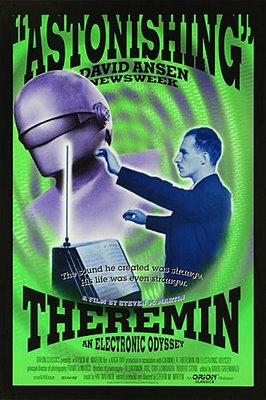
few days ago, in the writing of this humble blog will review amazed Mars Attack! , the B-movie more budget All times concocted cheerfully irregular a few years ago, but loved in this house, Tim Burton. As is customary in the center of wisdom, the viewing of the film was followed by the relevant symposium which, knife in mouth, we decided to gut the film in the style of Garcian. We took the bottle of whiskey from under the table, the ten cartons of Ducados and seeks to assess the controversial blockbuster millimeter.
After rambling about the virtues and vices of the greatest work of Burton Mars, put on a pedestal to Sarah Jessica Parker elucubrar decaffeinated and groped and conspiracy theories about what might happen on Earth if our planetary neighbors decide to visit, we emphasized (completely drunk at this point) in the fantastic soundtrack signed by Danny Elfman musician burtoniana fetish school. Searching the web, we found that employed the Elfman theremin, an instrument extraplanetary where they exist, to create the sonic backdrop.

Russian physicist Leon Theremin (real name Lev Termen) invented in 1919, this curious instrument that produces sound without physical contact by the interpreter. Good old Leon defined the concept as "ether music", hence the aparatejo in question is also known as eterófono.
The ethereal sound that was generated to emulate the timbre of the cello, as well as physical inventor was a cellist. And in general, intended as substitute for full orchestras. All without the hassle of having to handle the bow and the strings of a stringed instrument of life.
The classic theremin consisted of a box which came out two antennas, one vertical and the frequency controller and a horizontal charge to change the volume. If our hands close to the first antenna would get a high note that would become serious by keeping the hoof. With the horizontal antenna would the same, the closer it was the hand less volume. The result was a sound proper to the synthesizers of our time.
The Lenin himself was amazed discovery and Theremin sent to Europe to show the power of Soviet ingenuity. Leon came to the U.S. then where would play his instrument by the New York Philharmonic , selling a year later the business license of the RCA product.
In his American period, Leon was in contact with geniuses like Einstein, who once made his first steps with the violin, or Robert Moog that, based on the ideas of Russian would be enshrined as one of the most prominent sound engineers in the history of music. While Moog, you know, deserves a post all to himself.
After continuing his work in the field of sound and many musicians trained in the use of the Theremin, Leon turned to the Soviet Union in 1938, where he finished as a prisoner working for the KGB until 1956, when it regained its freedom. From then until his death in 1993 at age 97, Theremin continued to work tirelessly and passionately in his invention star. The same would serve to create the sonic atmospheres of Remember of Hitchcock, Lost Weekend of Billy Wilder or science fiction films as War of the Worlds of Haskin . In addition, many musicians would claim later the theremin as an instrument. Jimmy Page, for example, introduced this noisy machine live versions of classic Led Zeppelin Whole Lotta Love.

The Russian music Clara Rockmore, who died in 1998, and Lydia Kavina , both trained by our inventor of the day, are two of the most recognized Thereministes virtuous of all time. The filmmaker shot Steve Martin, for its part, the 1994 documentary Theremin an electronic odyssey , this documentary biopic sound wise.
If you have time, I leave this link where you will find information to build your own theremin. Moreover, this charming couple of videos, where they can enjoy the power of this instrument, a pioneer in synthetic music revolution. In the first of them, indeed, it is the Lion who runs his wonderful instrument.
0 comments:
Post a Comment